Media | Articles
Why on earth is an IROC Camaro worth more than a C4 Corvette?
There’s a certain order of things in the car industry. Some brands and badges just sit higher up on the totem pole of price than others. A Lincoln is more expensive than a Ford, a Lexus more expensive than a Toyota, a 5 Series than a 3 Series, etc. Convention also dictates that a Corvette is supposed to be pricier than a Camaro.
That’s certainly the case when shopping for new cars in 2022, and it was the case in 2012, 2002, 1992 and way on back. If Chevrolet’s pony car is the working man’s whip, America’s sports car is what the owner of the company he works for drives. If the Camaro is attainable, the Corvette is aspirational. You get the idea.
So what?
When going over our quarterly updates to the Hagerty Price Guide recently, we realized the status quo has been upset for a certain Chevy performance pair, specifically from those mustachioed muscle years of the 1980s.
Not only is a Camaro IROC-Z (1985–90) worth more than the equivalent base C4 Corvette (1984–96), it’s worth a lot more. More than twice as much, actually, and this reversal of things predates both the recent boom in interest for all things ’80s cars and ’80s revival events like Radwood.
Marketplace
Buy and sell classics with confidence
We have a major market anomaly on our hands, then. The situation is sort of like booking a guided African safari for cheaper than a trip to the local zoo, or eating at a restaurant whose steak is cheaper than the burger. To try and understand this contradiction, we found a pair of these star-spangled mullet-mobiles—Sajeev Mehta’s 1985 Corvette and Kay Yasoni’s 1988 Camaro IROC-Z —for a back-to-back drive on a (finally) cool fall morning in Houston, Texas.
We wanted to find out if, perhaps, modern car collectors are on to something that wasn’t obvious to General Motors product planners in the 1980s.
That wouldn’t be unheard of. Some of the hottest cars on the market were, at one point, thought to be attainable or less. A Mini Cooper from the 1960s can easily be worth as much or more than some contemporary Rolls-Royces; a Mazda MX-5 Miata can easily bring more money than contemporary Cadillacs and Lincolns—and that kind of makes sense.
This sort of thing happens all the time in other markets. Vincent Van Gogh died a failure. Now his works are priceless.
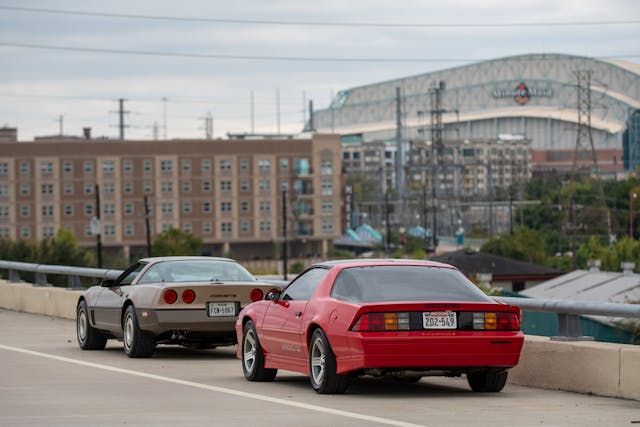
Debuting in 1982 and 1984, respectively, the third-gen Camaro and the fourth-gen Corvette were the right cars at the right time for General Motors. Both of their predecessors were long-in-the-tooth and near-caricatures of their former selves by the early ’80s. Thanks to computer-aided design, fuel injection and more sophisticated suspension, the General finally pulled these American sports cars out of the malaise era.
“We needed to get the Corvette back to the performance level of 1970,” said Dave McLellan, the Corvette’s chief engineer during the C4 years. Chevy mostly pulled it off, with Car and Driver calling the first all-new Corvette in 20 years “a true-born, world-class sports car loaded with technical sophistication.”
The Camaro, meanwhile, was another breath of fresh air that brought a completely new look to Chevy’s pony car, leading Motor Trend to award it Car of the Year honors for 1982.
The Z28 was the speediest Camaro upon the third gen’s debut in 1982, but from 1985 to ’90 the top dog in the lineup was the IROC-Z Sport Equipment package, often shortened by funny-haired gearheads everywhere to simply “IROC.”
The $659 option took its name from the International Race of Champions, a race series pitting the stars of NASCAR, Indy, and sports car racing against each other in identical Chevy Camaros.
The actual IROC race cars weren’t much more than Camaro-shaped shells on top of a NASCAR tube chassis. But, like any good car company, Chevrolet was never one to miss a marketing opportunity and slapped IROC decals and a body kit on its latest flagship Camaro. Uprated suspension, bigger sway bars, upgraded wheels and tires, fog lights, and a choice of V-8 engines came with the stickers.
For the second half of the 1980s, the IROC was the Camaro to have, with the most power and, of course, the most flash.
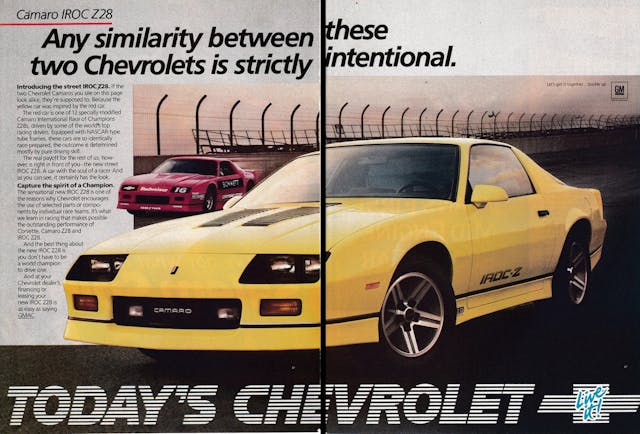
For 1988, Chevrolet slimmed down the Camaro lineup by dropping the LT and Z28 models, leaving only the base coupe and the IROC-Z. Although a taller final drive was paired with the 350 engine, its output kept rising, up to 245 horses for 1990. The International Race of Champions series began using Dodge Daytonas in the ’90 season, so Chevy dropped the IROC-Z package in 1991, reinstating the Z28 as the range-topper.
Owner Kay Yasoni’s IROC is a bone-stock, Bright Red ’88 model with the desirable L98 350 and T-tops, and it has gotten the kind of restoration work normally seen on older, more valuable pony cars. Maybe it’s the color, or maybe it’s because I haven’t seen such a clean third-gen Camaro in 20 years, but this car looks fantastic, even next to the Corvette that was supposed to be the premium offering. Its wedgey angles have aged well.
The inside is straightforward ’80s GM (plastic, lots of plastic) with gray cloth seats and right angles everywhere with square vents, stereo, and switchgear. The only things that are round, other than the leather-wrapped steering wheel, are the simple gauges—speedo on the left, tach on the right, and auxiliary readouts in the middle. It’s more restrained than one might expect for a decal-laden performance car named after a race series, but it is functional.

Easy-to-remove glass T-tops offer a clear view of the sky above, and aside from a hint of red fenders and hood vents, there’s a panoramic view of the road ahead as well. I may have forgotten my Whitesnake cassette, but it turns out I didn’t need it—driving this IROC turns back the clock plenty.
As a performance car, the IROC both then and now leaves something to be desired. As a time machine, though, it’s hard to beat. It’s a fun car that people fall in love with it because it brings back memories and feels very of-its-era.

The crisp body produced 24 percent less drag than the C3, the rear hatch offered more space for luggage, and the clamshell hood offered more room to service the engine. A “uniframe” chassis combined a traditional rail frame with separate frames for the windshield and B-pillar. A removable targa roof bolted in between the A- and B-pillars.
Front A-arms and spindles were computer-designed and for the first time and made from forged aluminum, while the compact multilink rear suspension sported a transverse fiberglass leaf spring. An all-digital instrument cluster gave off Tron vibes in a time when most cars had only recently gotten an itty-bitty digital clock.
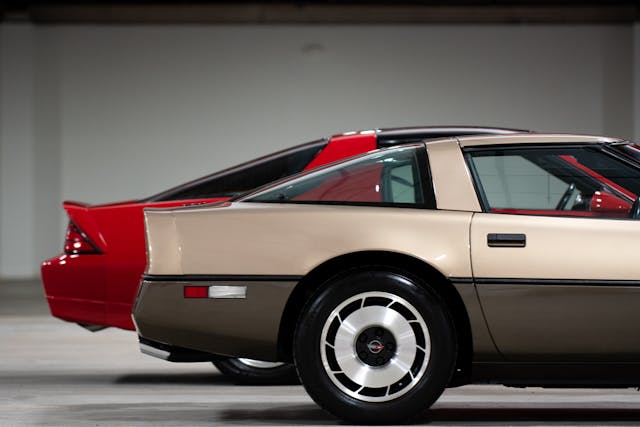
Despite that, initial reviews complained of the new Vette’s jarring ride as well as incessant creaking and rattling from the plasticky cabin. GM improved the ’85 Corvette’s ride with softer spring rates, while the 350 cubic-inch, 230-hp L98 engine debuted under the hood. The workhorse L98 would power the base Corvette until it was replaced by the 300-hp LT1 in 1992. Transmissions were still either automatic or, from 1984-88, a “4+3” manual built by Doug Nash that was essentially a traditional four-speed with overdrive on the top three gears.
And even though the IROC has a racy name, the Corvette wouldn’t be America’s sports car without some motorsports history of its own to back up those crossed flags on the hood.
In SCCA Showroom Stock GT racing, C4s swept the Playboy and then Escort Endurance Championship from 1985–87, and there was nothing the Porsche 944 Turbos could do to stop them. So dominant were the Corvettes that they were booted into the single-marque Corvette Challenge series.
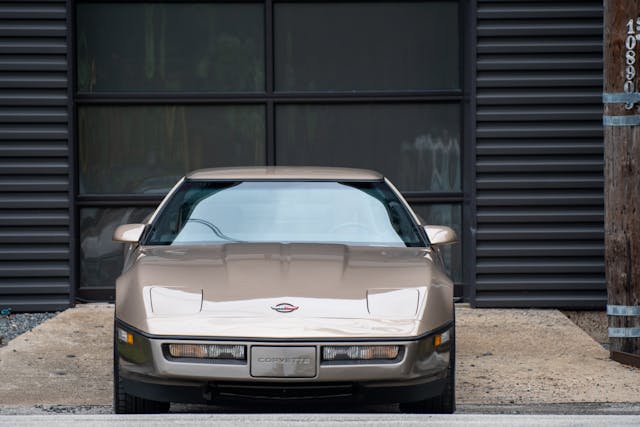
The enormous door sills make getting in and out of a C4 a challenge for anyone, least of all for the 50-somethings who typically buy Corvettes. They say you shouldn’t wear a skirt when driving one of these cars, but it’s awkward no matter what you’re wearing.
If the Camaro’s interior is a cabin, the C4’s is a cockpit. A slightly cramped one that nestles you in between the aforementioned sill and an equally tall transmission tunnel, the green and orange glow of that arcade-game instrument cluster greeting you from behind the two-spoke steering wheel.
If squeaks and rattles were standard factory equipment on the C4, as the old joke goes, they left them out when building this one. It was no noisier than the Camaro. We didn’t take the roof off, though, which in a C4 allows the body to flex and creak through corners and over bumps.
Even with the roof on, a C4 lumbers and rolls through corners more than one might expect, feeling planted but certainly not light on its feet. Step on the go-pedal, though, and the car livens up, feeling as though its 230-horse, 330 lb-ft torque ratings are delivering more than what the digital speedometer is reading (a hybrid-analog-digital dash arrived in 1990; dim or failing gauges are common on the earlier cars).
These two bowties weigh within a hundred pounds of each other and share the L98 engine, but the Corvette feels considerably quicker.
When the ’80s kitsch falls away, you’re left with a more purposeful sports car than the contemporary Camaro. The Corvette is lower, quicker, more exciting. It’s a more entertaining experience behind the wheel whether you’re driving it or sitting in traffic. Even the interior’s gimmicks and eccentricities lend a sense of occasion missing in the IROC’s sea of plastic.
Of course, this is as it should be. The Corvette was then, as now, GM’s performance flagship and cost more than even a loaded IROC when new (an IROC could get to $20K with options, but the ’85 Corvette started at $24K).
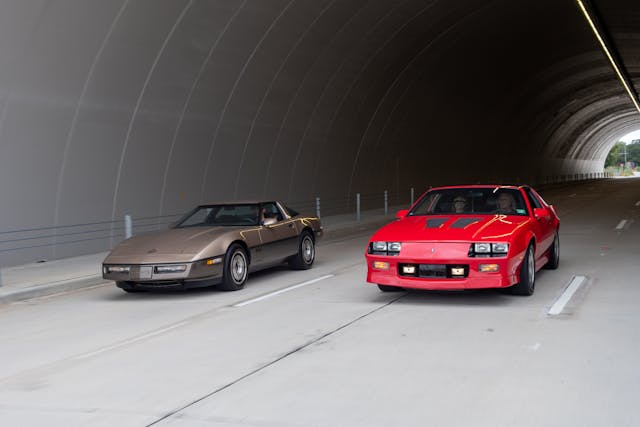
Why are low-mile IROCs storming through Bring a Trailer for prices over $40,000 and even $60,000 while base C4s in similar condition are lucky to sell in the 20s?
There isn’t one big answer, but there may be a few smaller ones. One is the rarity of good-condition IROCs. Chevrolet sold third-gen Camaros by the lot, but IROCs were expensive. Kay’s red coupe is one of 24,050 IROC-Zs sold in 1988, but only about half of that number came with the big engine.
Also, many IROCs lived hard, well-used lives, and as they aged they were frequently left to the elements. Meanwhile, Sajeev’s C4 is one of nearly 40,000 Corvettes sold for ’85, and if the typical IROC buyer was out looking for a stop light drag, the Corvette owner was a middle-aged family man who only drove it on the weekends. As such, the C4 survival rate is higher, the typical mileage lower.
There’s also the fact that while the IROC-Z is top dog among third-gen Camaros, an early C4 has to look at the taillights of Callaways, ZR-1s, Grand Sports, and even later base cars. Mehta’s bronze beauty is a very nice car, but it’s no “King of the Hill” ZR-1 (although even ZR-1s remain relatively affordable).
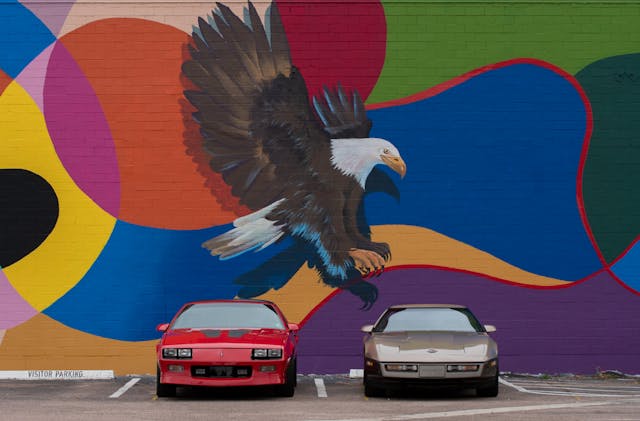
Meanwhile, Gen Xers apparently go gaga for third-gen Camaros. Although Gen Xers make up 32 percent of the market as a whole, they own about half of the IROCs insured with Hagerty. IROC values started to soar in 2014, about when this generation of enthusiasts entered their high-earning, mid-life, fun-car-buying years. That’s probably not a coincidence.
Last but not least, there are impossible-to quantify matters of perspective. Even with the old jokes about mullet-wearing owners, these Camaros really play to nostalgia—a powerful force in any collector market. For those of a certain age, the IROC was the attainable car they dreamed of—the car the coolest kid in your high school might have driven. The C4 Corvette, rightly or wrongly, may be remembered as something your buddy’s dad drove, probably while wearing New Balances and high socks.
Even the C4’s technological advancements might work against it in the minds of collectors. It hails from an era when General Motors squandered a fortune on technical solutions, from paint-shop robots that wound up spraying each other to plastic-bodied compact cars that couldn’t match the refinement of contemporary Hondas. It’s also sort of stuck in a middle ground where it’s too new and electronic to really be considered a “classic” in the sense of a C3, but at the same time it lives in the shadow of the much faster (and today not much pricier) C5.
I still don’t get it, though. The massive gulf in value between these cars that used to share showroom space is just too big to make sense, and if one is undervalued, maybe the other is overvalued. Either way, it’s yet another case of why the car hobby is not always a rational one.
Check out the Hagerty Media homepage so you don’t miss a single story, or better yet, bookmark it.







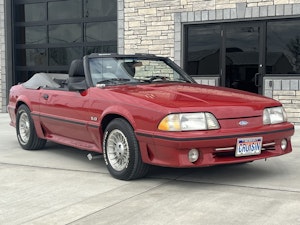

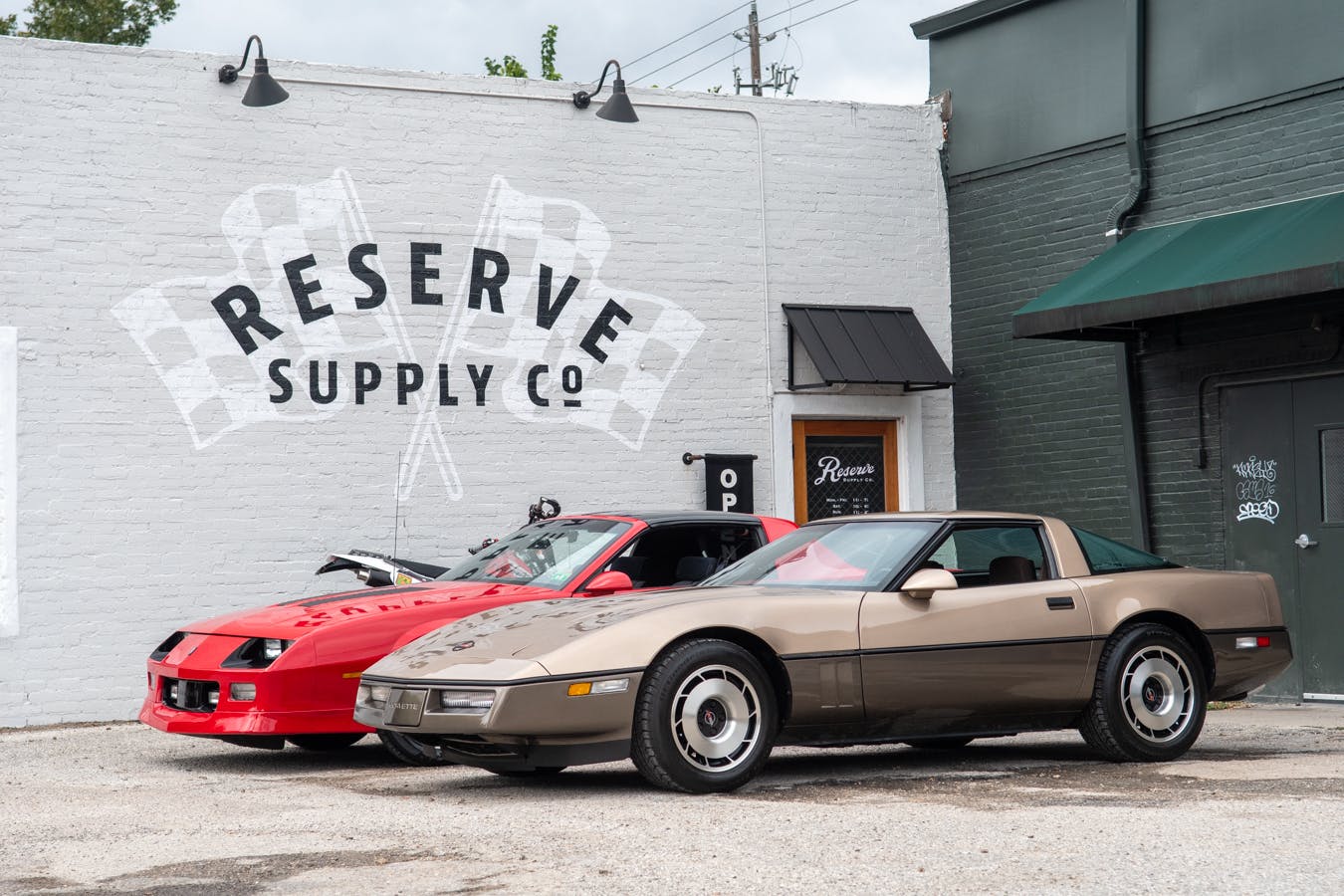
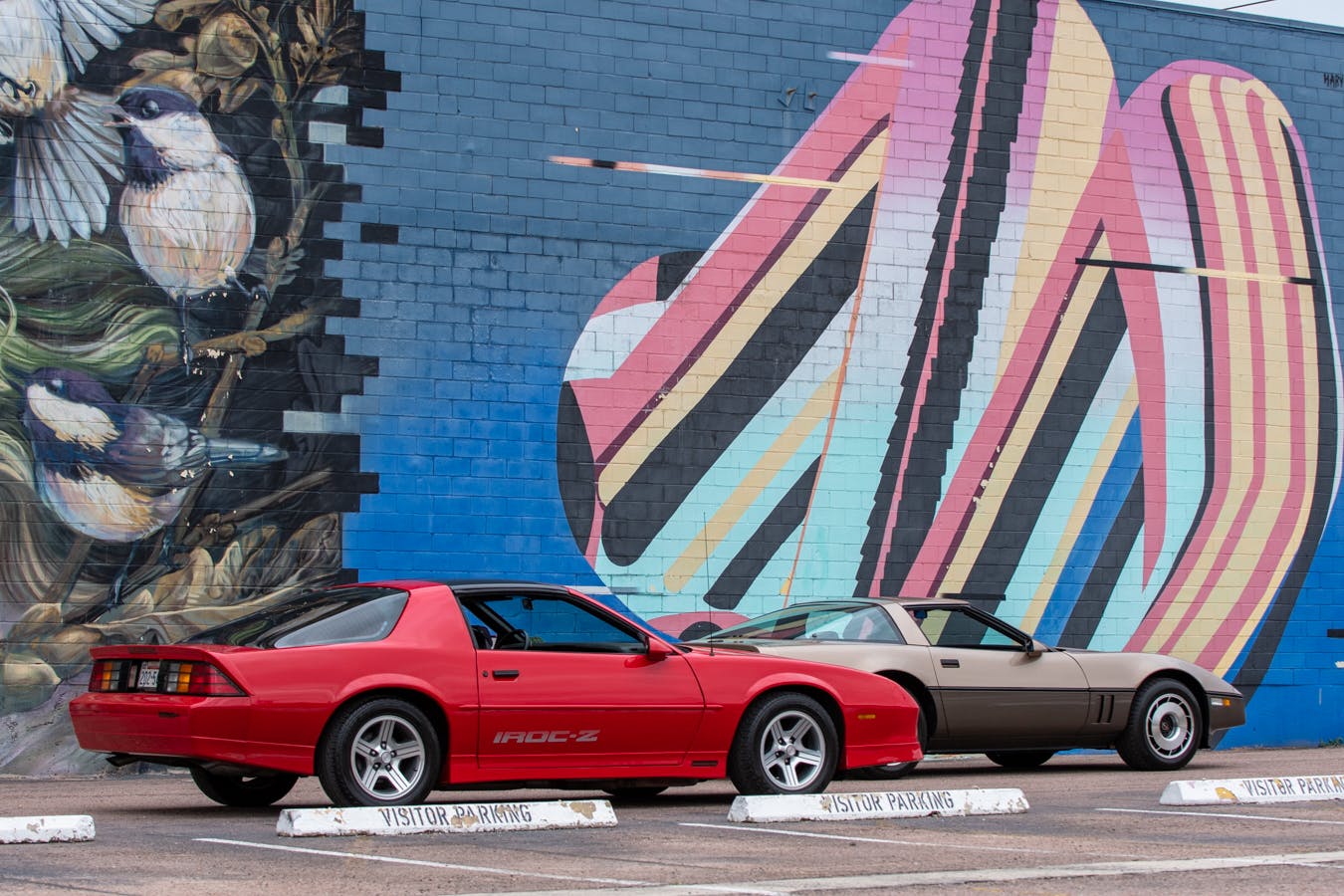

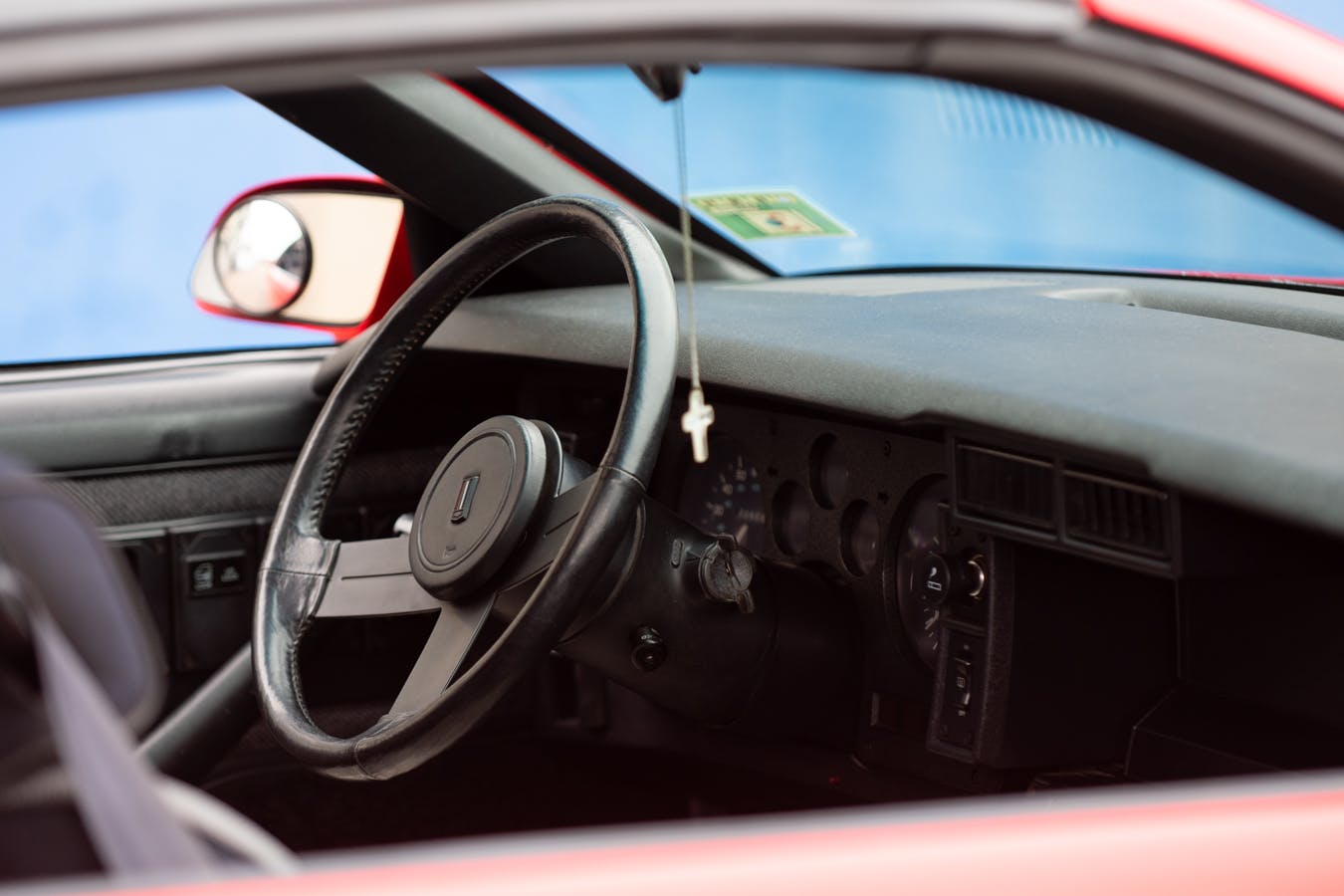
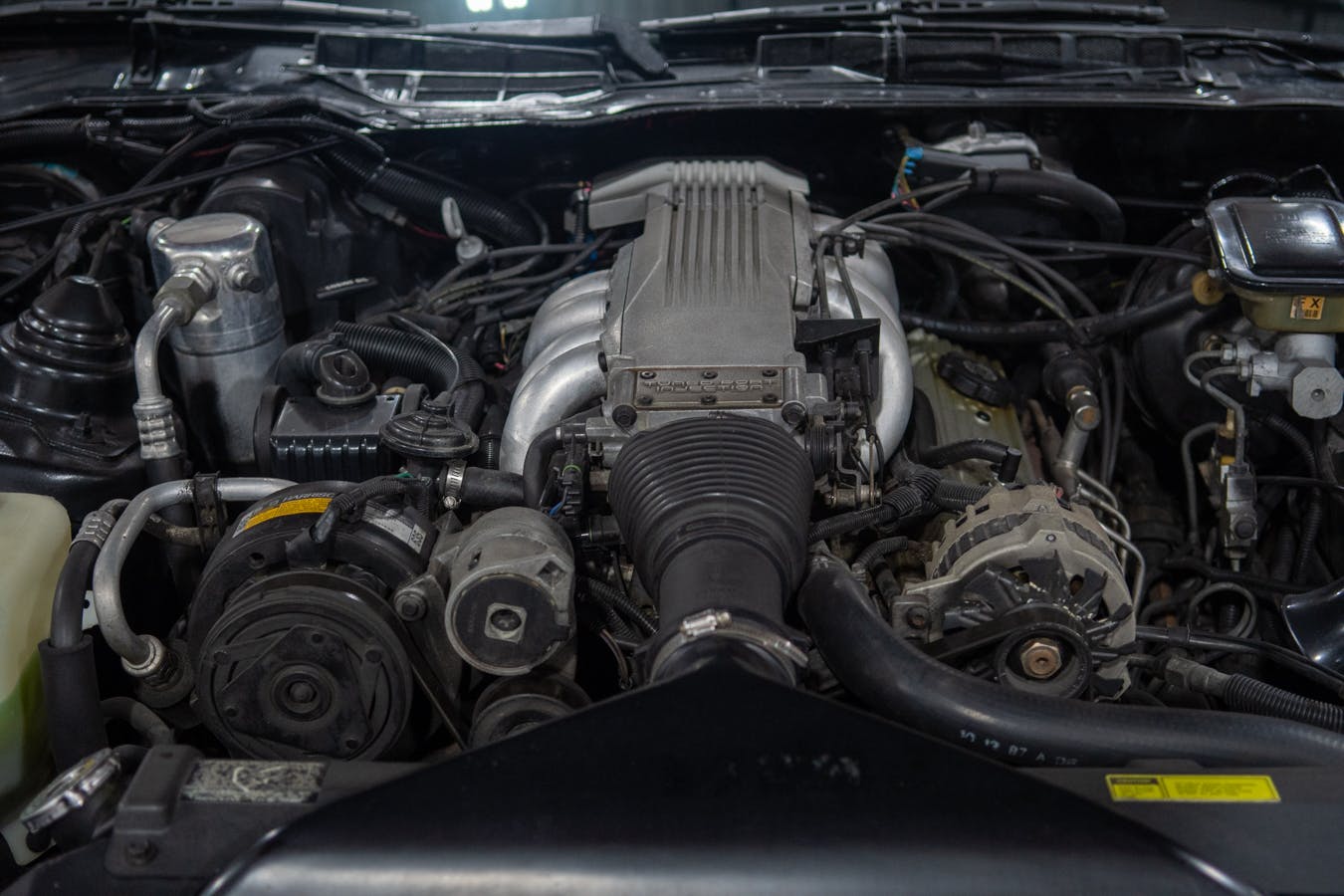
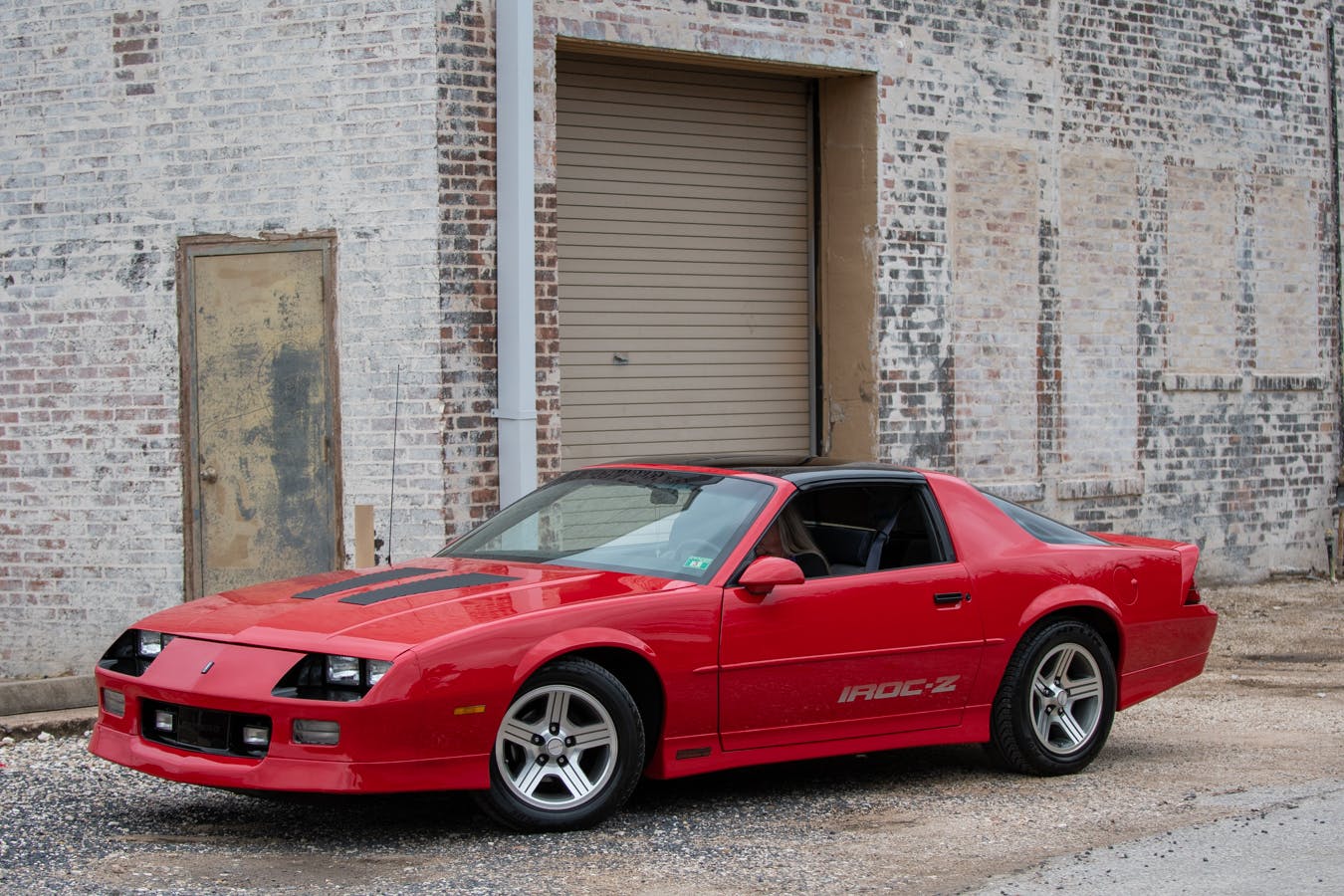
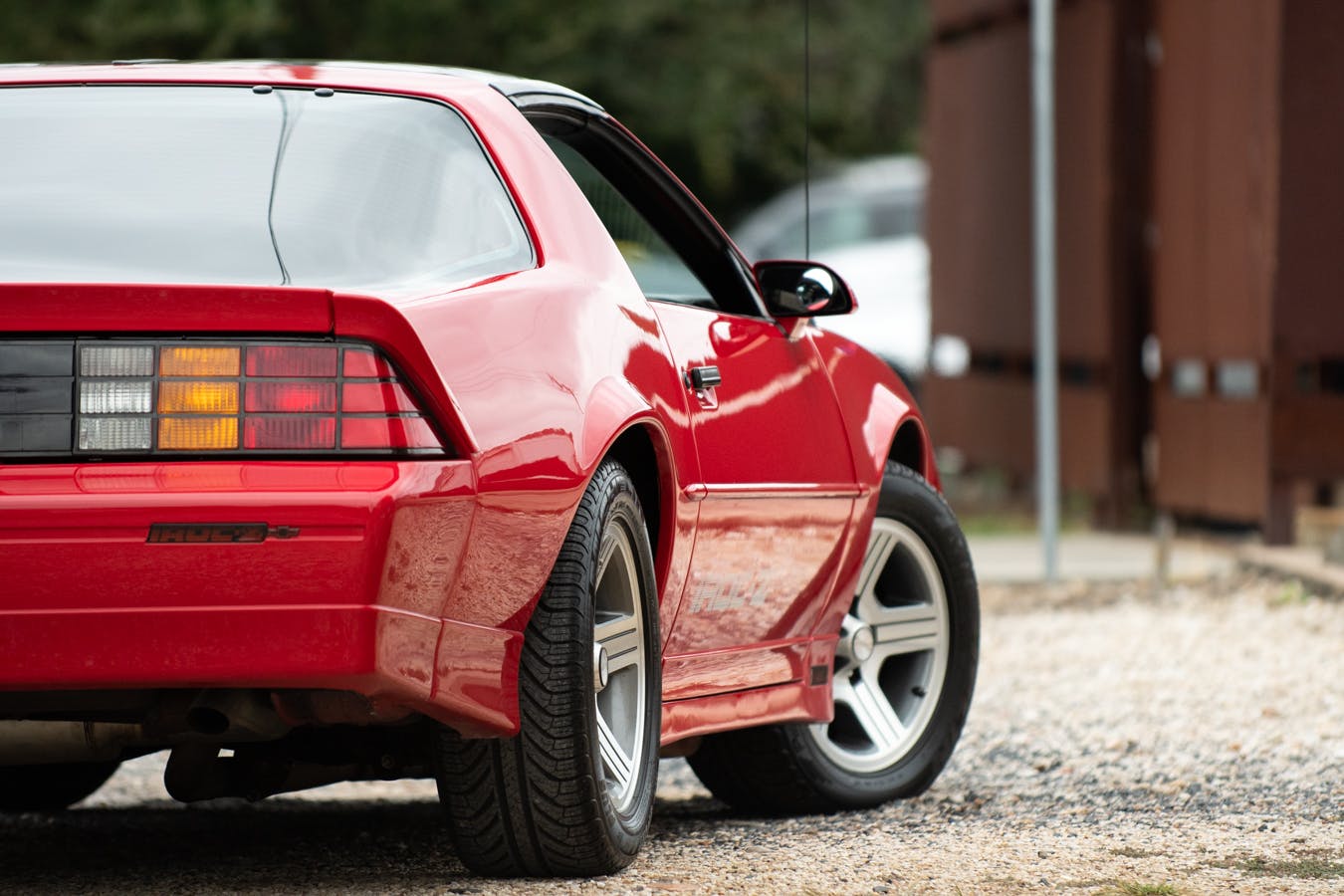


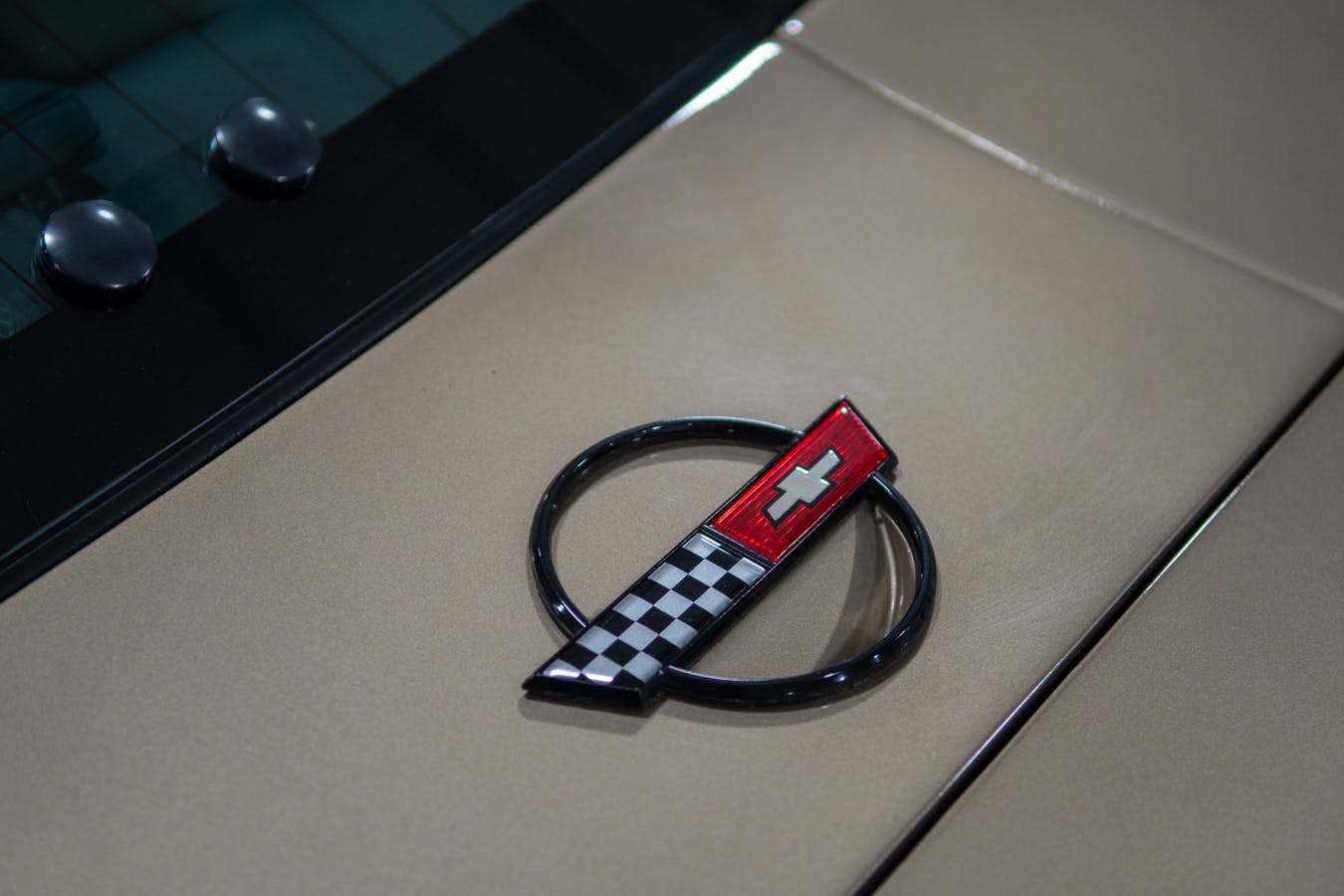
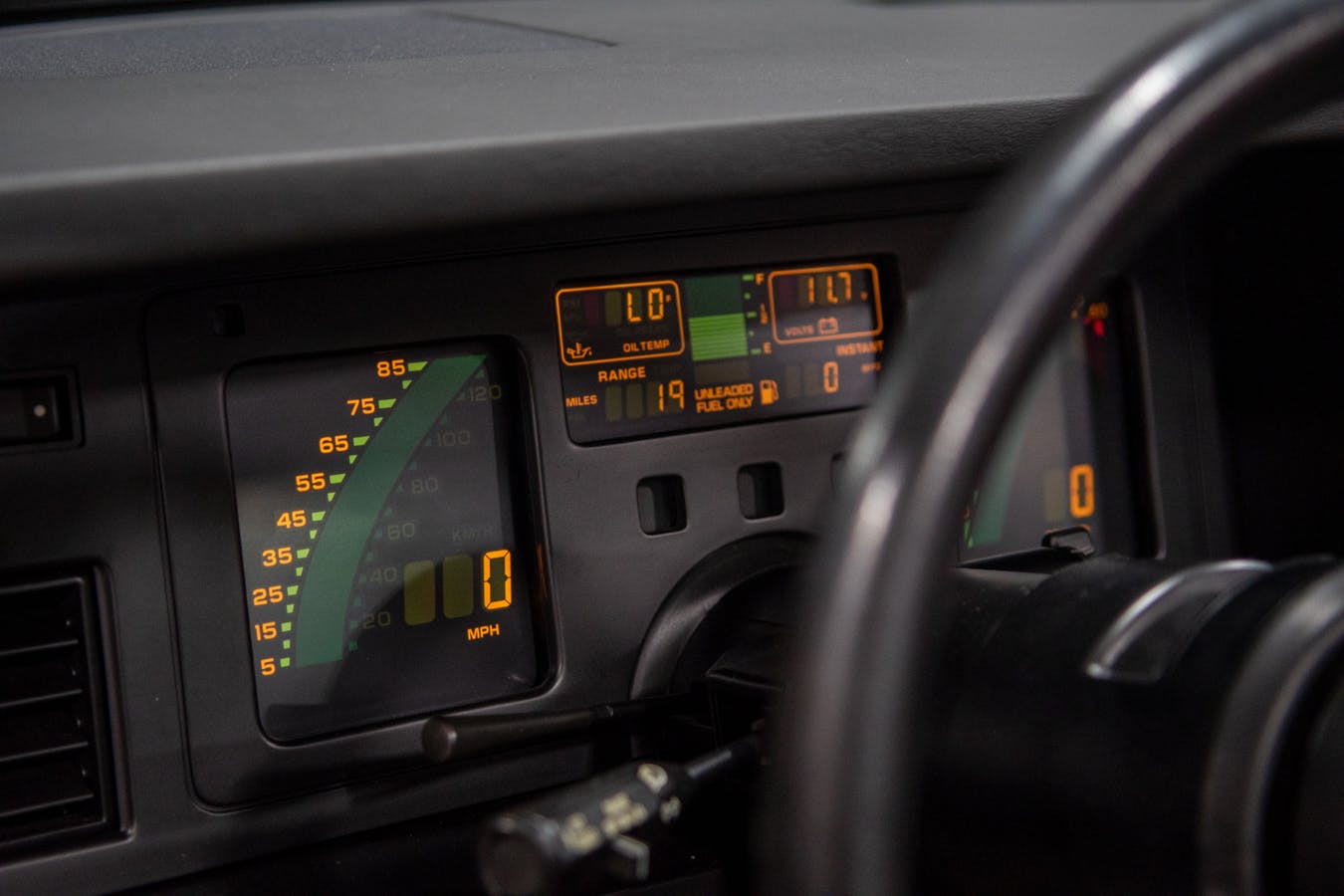
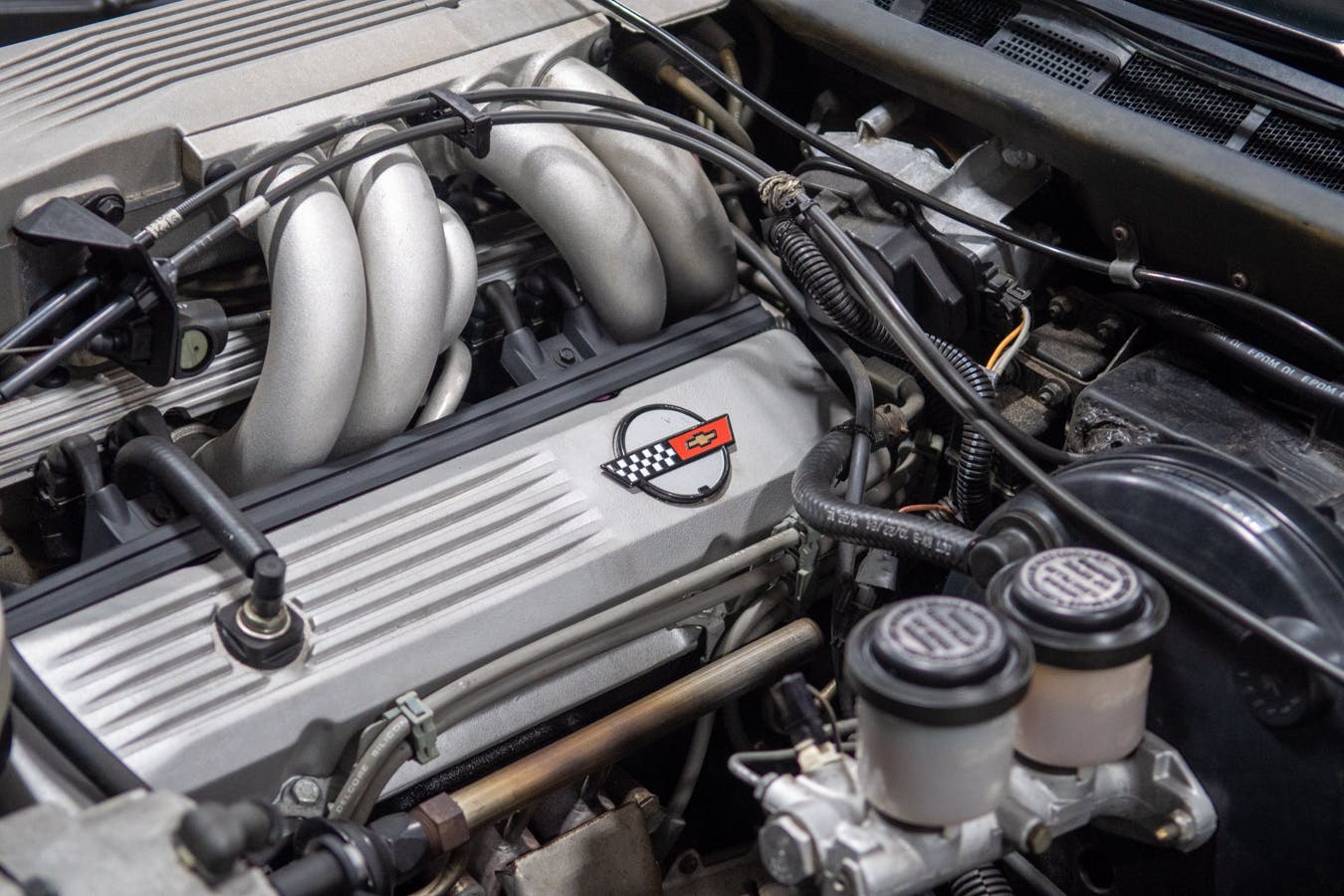
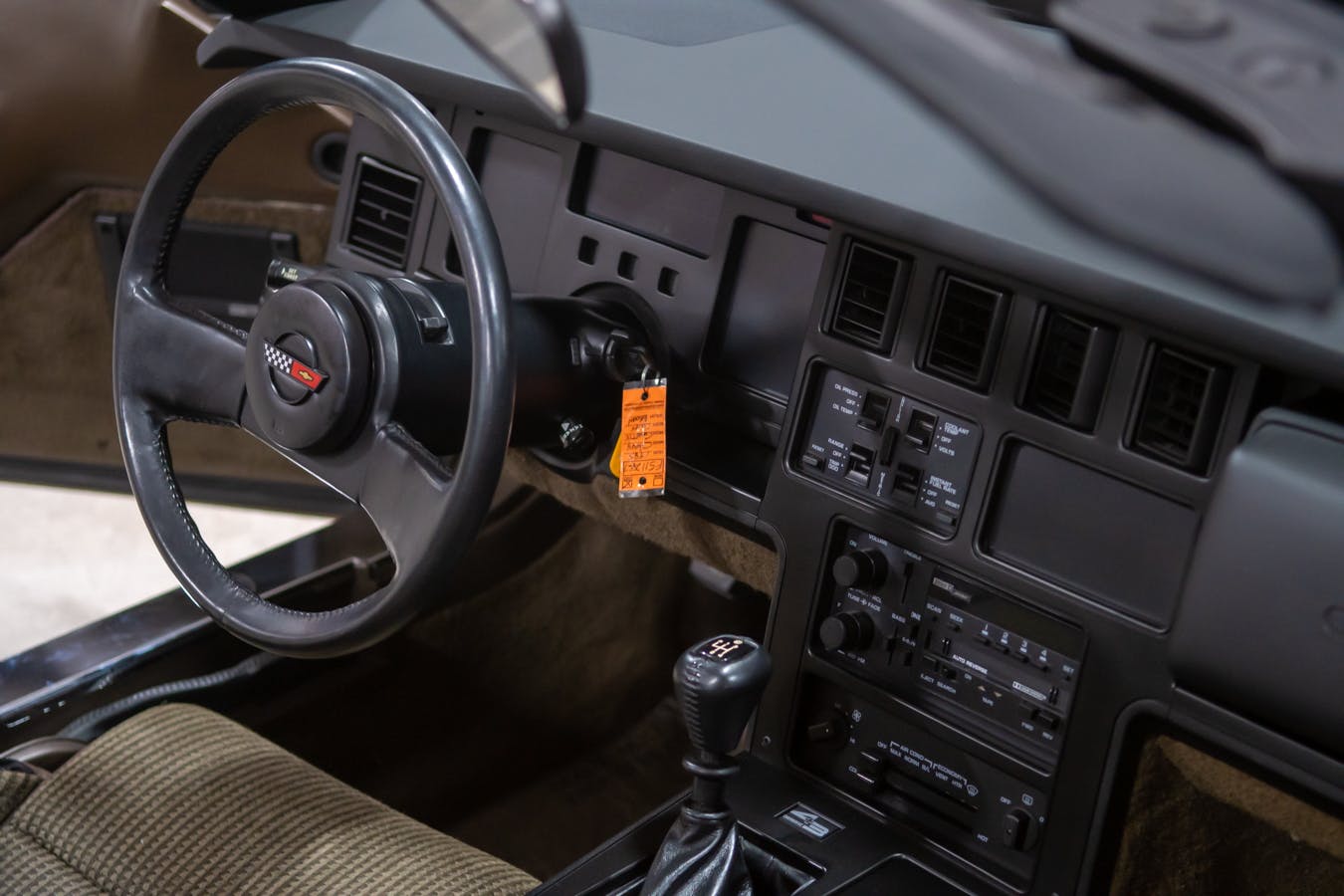
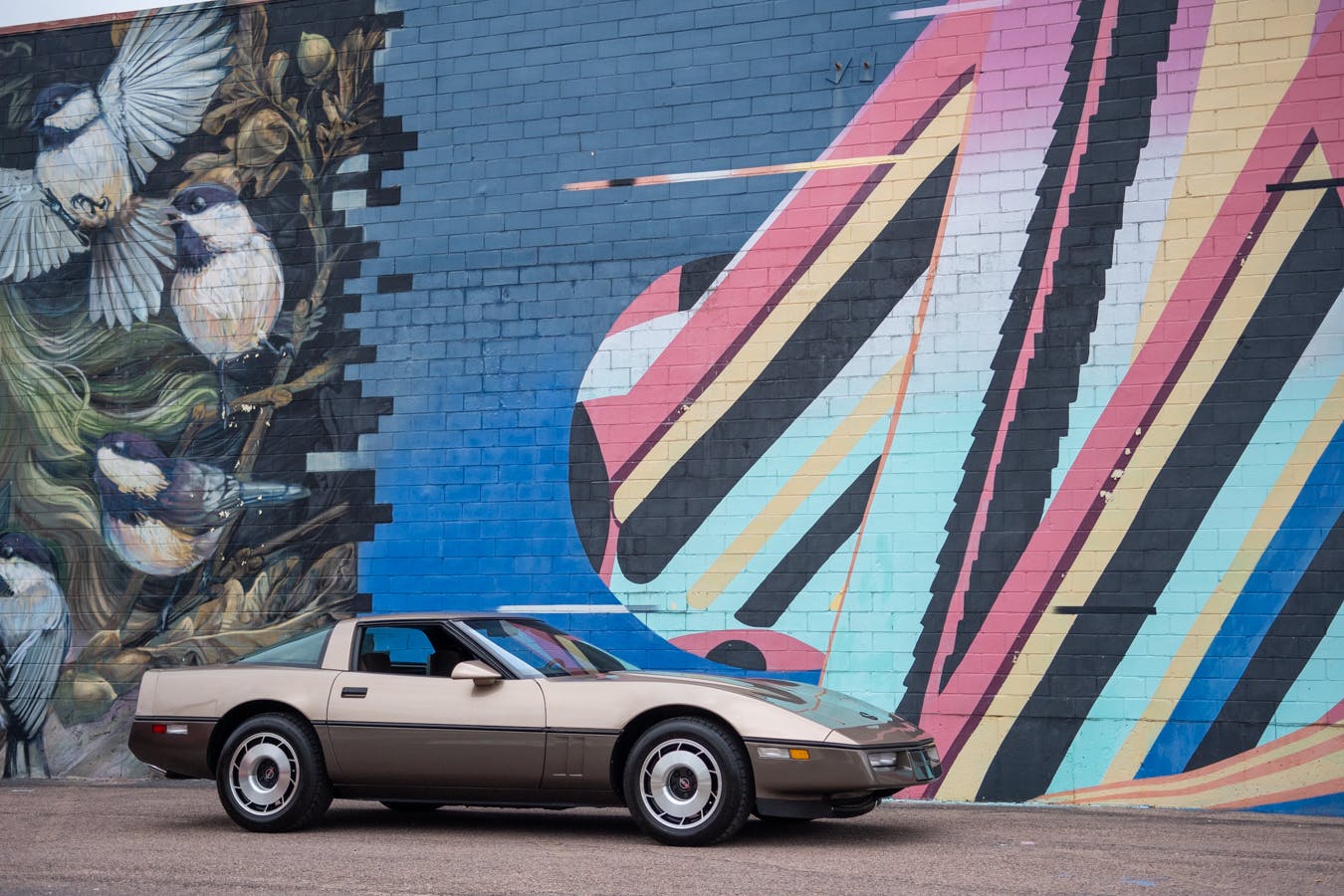
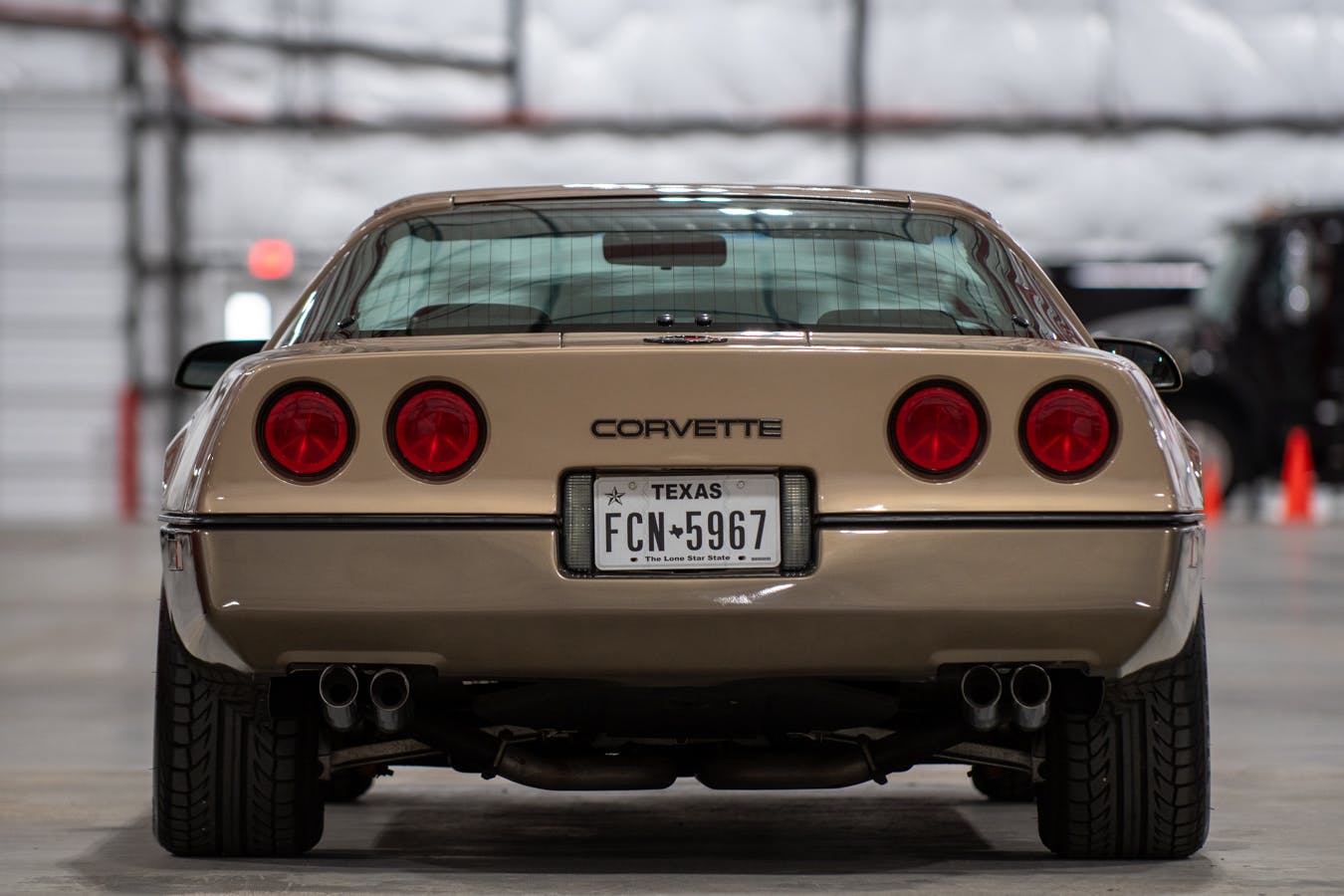
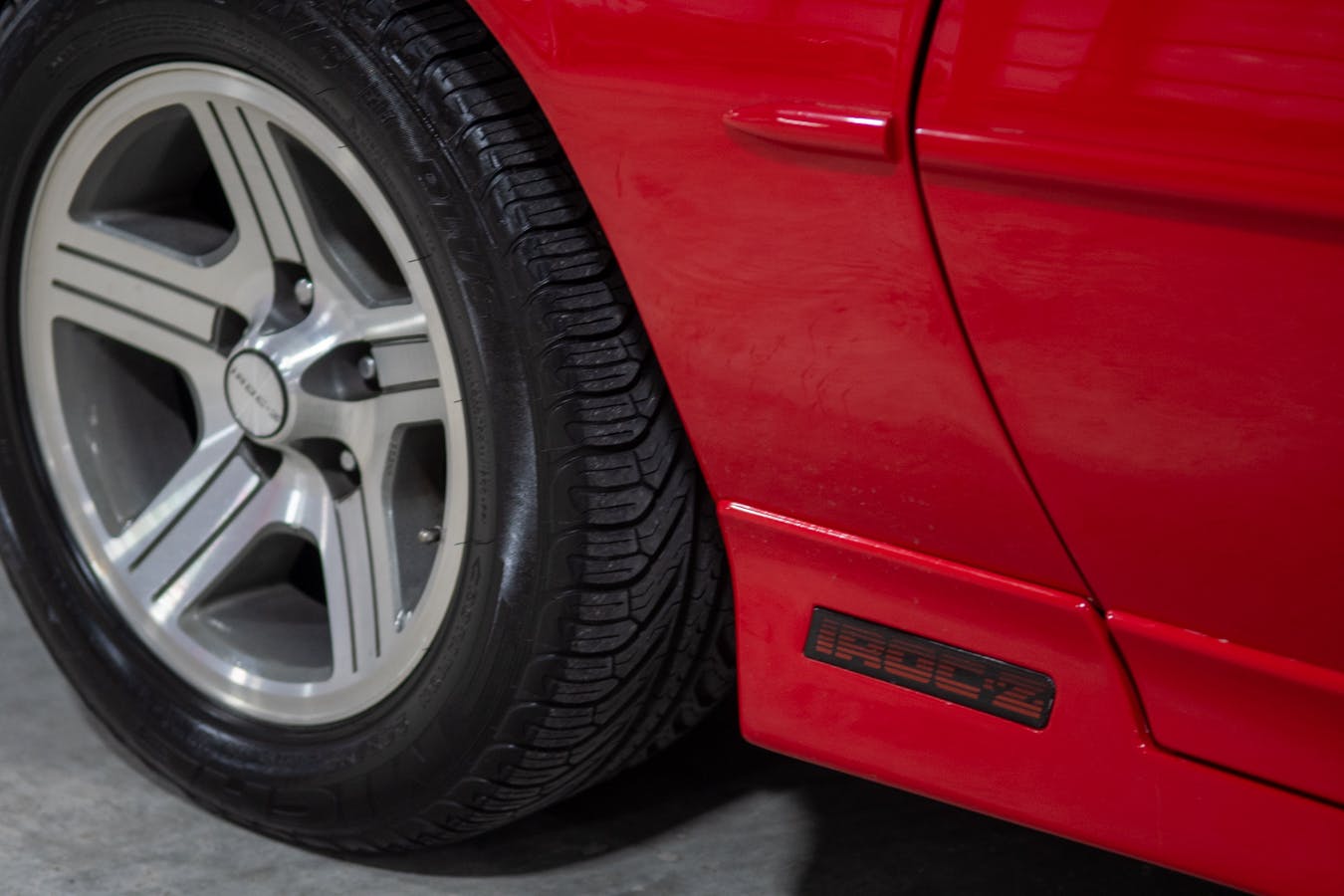
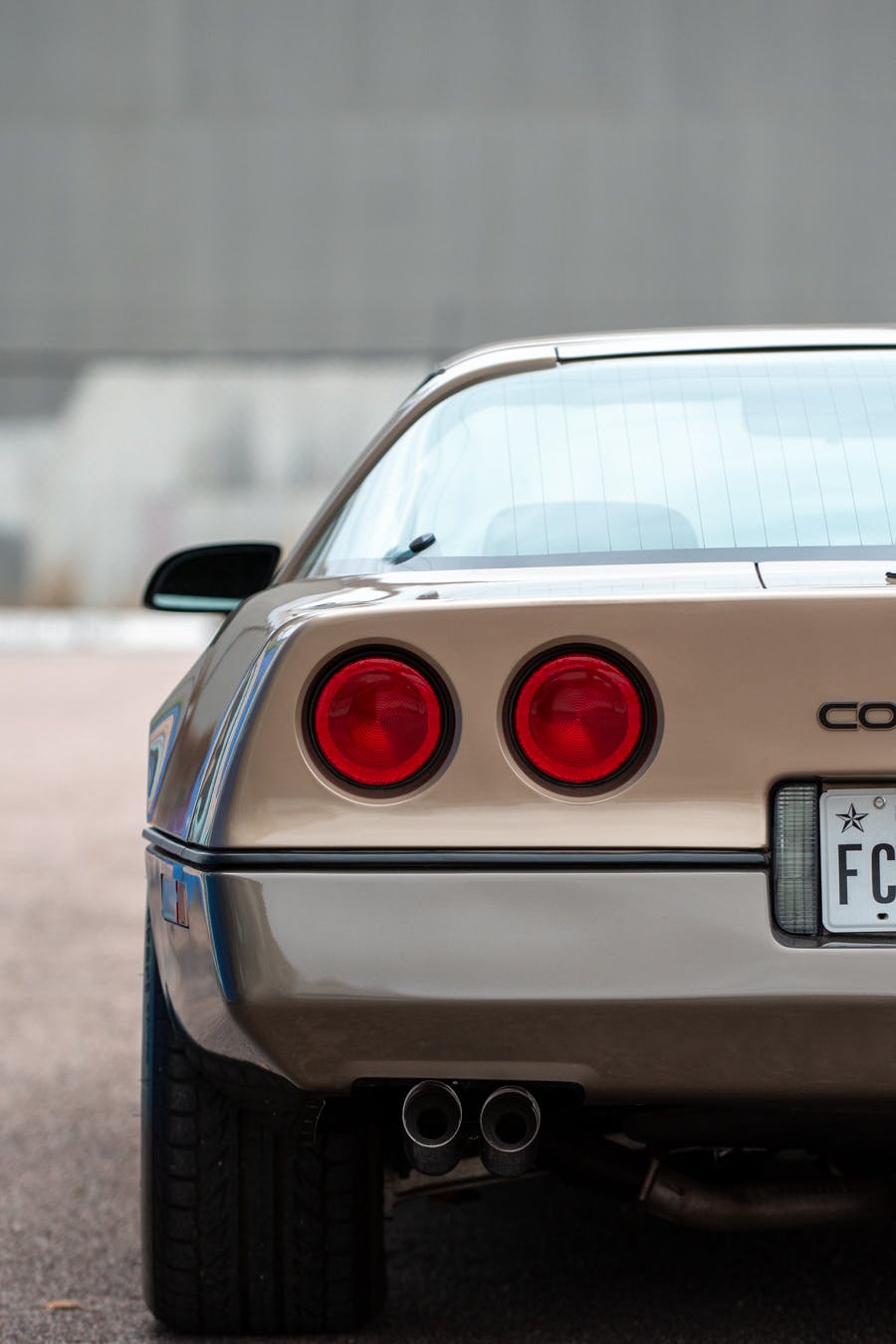
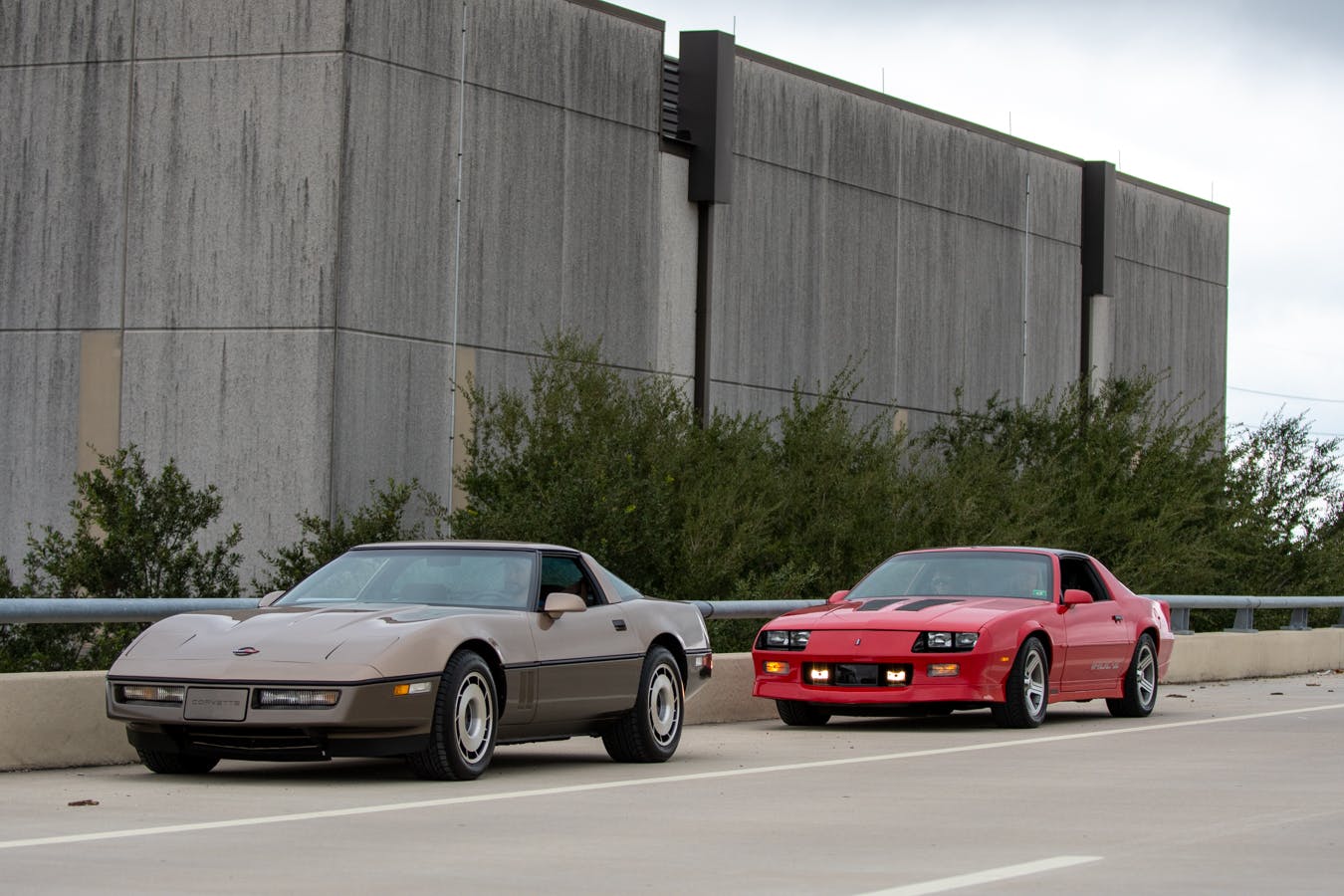
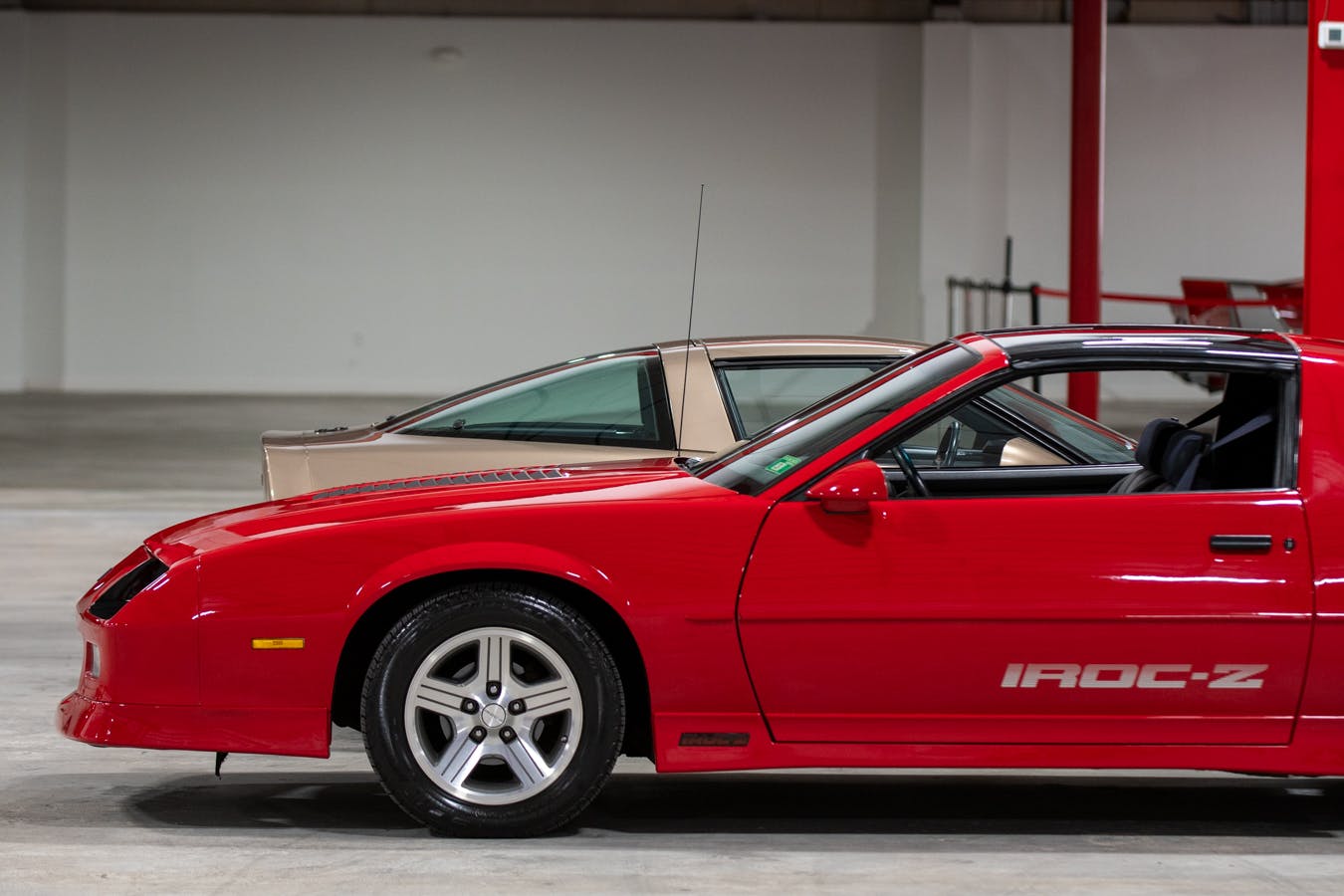
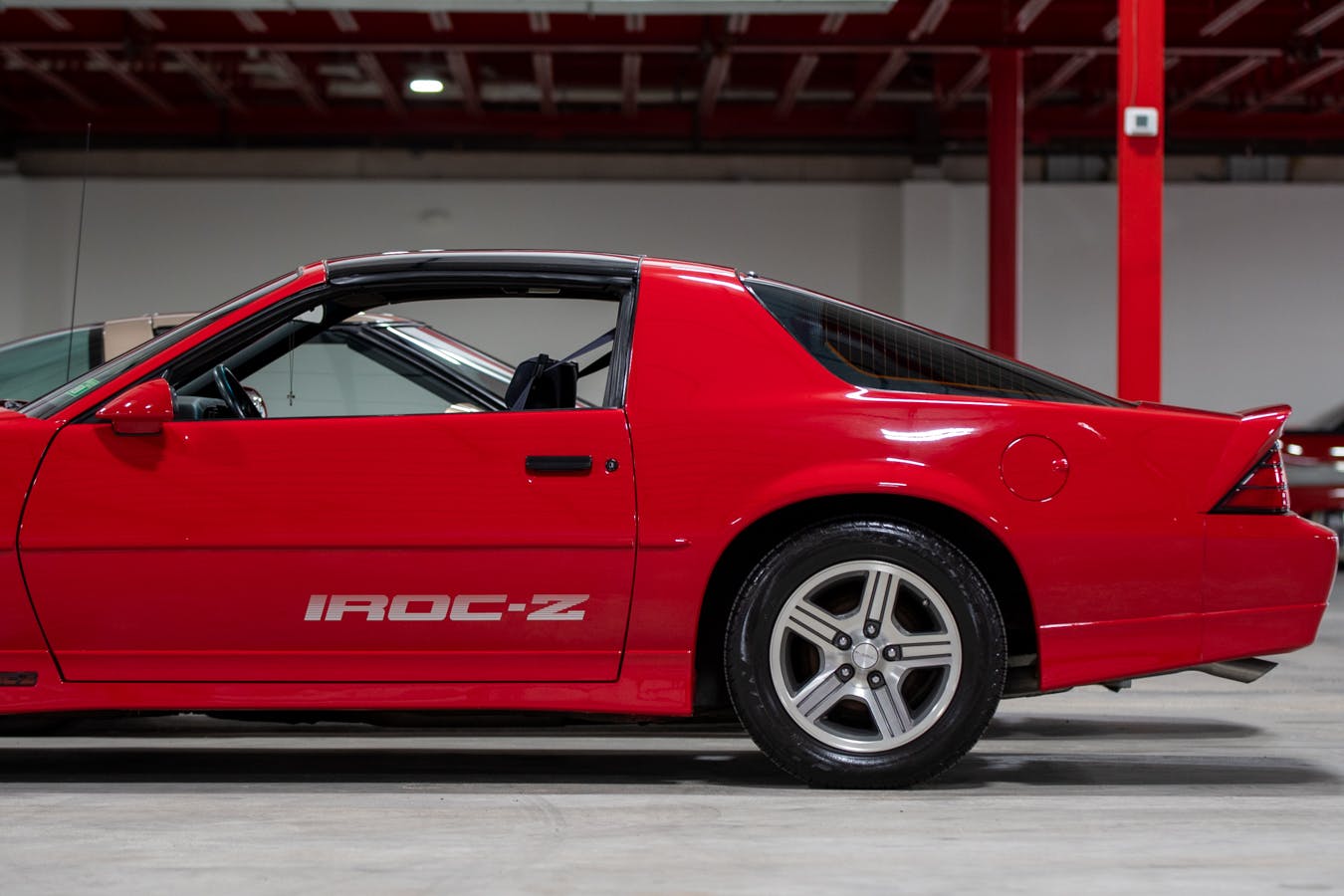























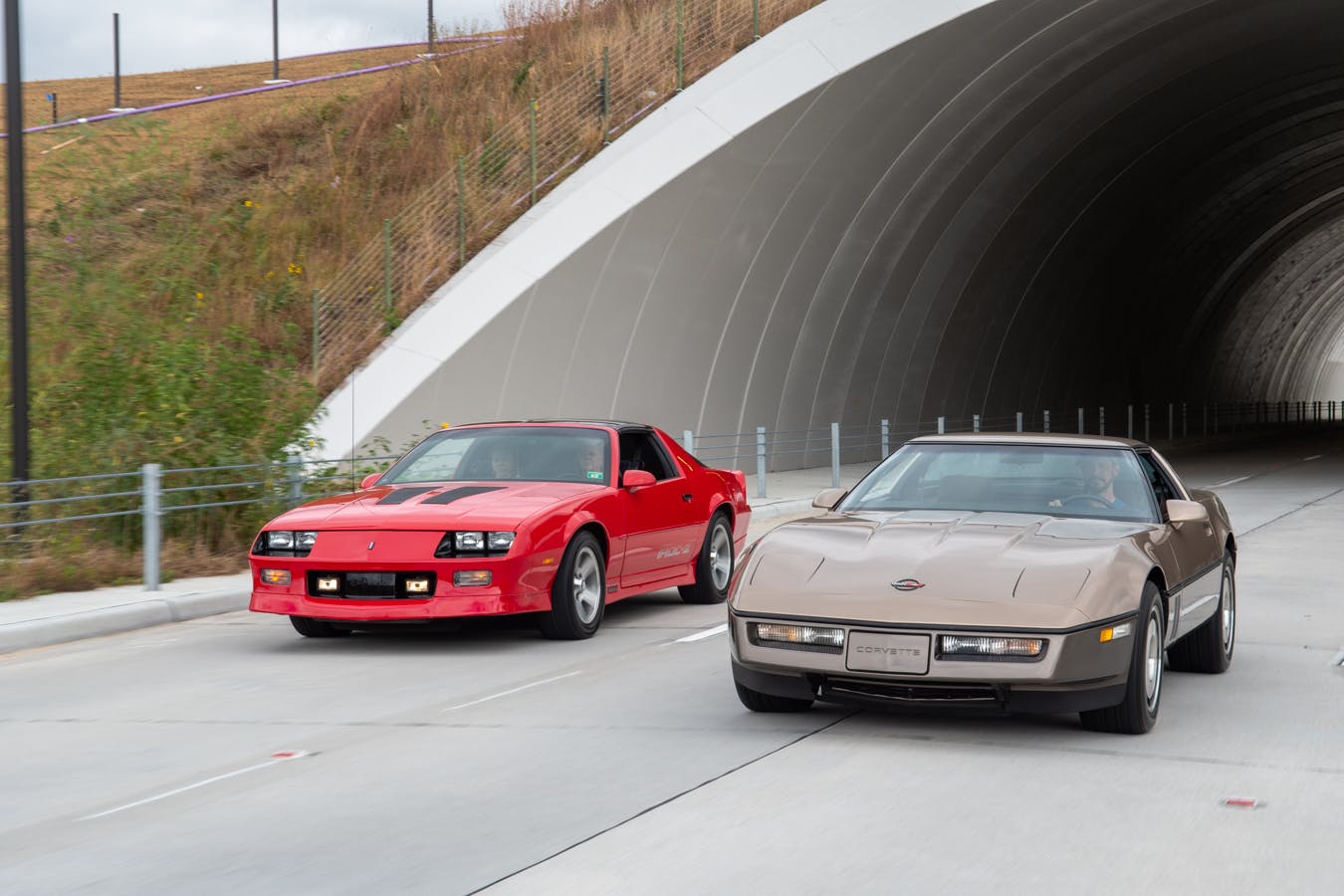
When my business got slow in the early 90’s I was concerned about making my next mortgage payment etc.. so I sold my 1990 ZR1, black on black that I had to beg the dealer in Menlo Park to sell me because my credit was too low. The salesman that I am convinced the salesman and I got the car. When I had the money the following year I asked the dealer I sold the car to where my car, I wanted to buy it back.. so there was good news and bad news. The good news was he found the car, the bad news was it was in Japan. So that ended that. Many years later and years of working hard I have a ’67 427/435 coupe and a 2003 50th anniversary Z06 in the garage That I bought new. For me Corvette is the ultimate machine. Camero’s not so much even though I was looking at them in the 80’s but never pulled the trigger. These days when I open the garage door and want to pick my ride for an afternoon drive I almost take the ’67. Just more thrilling of a ride and that’s what I like about the 67. When I’m going to Mecum in Montery in August I take the 2003 Z06. Both have their purpose but for me a teenager in the 60’s it was always going to be a Corvette.
Nothing special about a base C4. Front very bland. All the nice swooping lines of C3 gone.
I have a 1988 Pontiac Trans AM GTA and 1990 C4 both are fun to drive. The C4 is a pain for a fat old guy to get in and out. Unlike the GTA but personly I like driving the GTA better on day trips. It seems to be heavier in the corners smother
I would say that today’s buyer may be more on the practical side as well. They can justify a 4-seat car easier than a 2-seater. Makes the purchase for us family guys easier to explain to our better halves, and allowing the younger generation to enjoy the hobby more when everyone can go for a ride together.
I don’t care what it’s worth to others, I still enjoy my purchased new 150,000 mile C4 with it’s classic clean lines, instant throttle response and mountains of torque.
Having sold Chevrolets in 1984 & being exposed to not only the “hype brochures” of what it was “suposed to be” compaired to “what it was” but also the copious amount of “privlaged/confidentual service buletins” issued for that car the only surprise here is that it took the market this long to understand just how bad of a car it truley was. I didn’t stick around for the 1985 to come out. My ethics were more important to me. I quit selling Chevy’s. .
Having followed the Corvette market for decades and always lusting over various versions I finally found myself in a position to get one last January. I’ve owned many different types of vehicles over the years–1967 GTO 4 speed,68 Camaro SS 4speed,1970 AMC Rebel Machine and many others of different sports car varieties. I still couldn’t get over my first experience in a new 1970 Corvette 454 4 speed. It left an impression on me that has stuck with me through the decades since. So, when I found a 1992 C4 convertible in Quasar Blue with black top and a 6 speed I knew I’d found the right one. I had driven a C5 6 speed prior and liked the car but it just seemed bloated in size compared to the C4. The C4 just felt more of a sports car than any of the later versions. Does it have faults? Yes, but most of the squeaks and rattles can be dealt with by some time insulating areas where trim and interior bits meet. The drivetrain is very stout and can take a lot more power if you are so inclined. I’ve enjoyed the car so much that when a same year ZO7 coupe came up for sale locally I had to have it. So now I have the best of both worlds. One for top down cruising and one for HPDE and other times when the right foot gets itchy and you have to extend it to scratch the itch. Bottom line is the C4 is still a hell of a deal if you want a lot of bang for the buck. And I’m still in to both of them for less than 20K combined. Being on the thin side helps with my entry/exit which is still a bit of a procedure but once inside it’s like being in a cockpit that helps keep you in place during hard cornering. Can’t say that about the Camaro or Fox body Mustangs of this era. I’ve owned 4 NA Miatas and I compare the driving dynamics favorably to them in that with good tires they just grip. A well sorted C4 is just about guaranteed to put a smile on your face and if the dynamics are more important than the attention of others then you could do a lot worse.
If you are interested in one now is a great time to buy as the market has been of the rise for the last two years but has slowed during the fall/winter. I’m thinking come spring it will be headed back up. Manual trans bring more with both varieties but the 6 speed is superior and pretty bulletproof if taken care of. There is great support on the forums and most parts are available from a variety of vendors.
I am lucky enough to own both of these cars today and I lived in the era when they were both introduced to the market as new cars. I was 18 years old when the new 1982 Camaro was introduced and Motortrend magazine declared it the ‘car of the year’. I also own C3 corvettes.
The C4 Corvette was an all new space aged race car but only for those older individuals who could afford it. It was not the classic Corvette any longer. The IROC Camaro was a young gearheads dream. These cars were always big brother and little brother in GM’s eyes. The Camaro was not allowed to be faster.
Age plays a big part in all of this and demographics. Carguys remember where and when they saw one of these cars in action. Etched into our brains, in detail, the cars the place and the time set in stone the desire to own one.
Your article hits on all the relevant points and history of the era and these two cars. Whether it be in a high school parking lot, race day or cruising Main Street on Saturday night, we remember the sights and sounds and desire to own one of these cars.
GM is a master at marketing and both of these cars were prominently displayed in the Corvette Challenge Series and the Players Challenge Series for IROC Camaro’s hence RPO B9P and 1LE. So race on Sunday sell on Monday as the saying goes. I will tell you that the cars being displayed in my opinion are not a fair representation to compare. The 85 Corvette compared to the 88 Camaro is not equal. The Camaro is really the best version of the car as it moved up from 1982. The 85 Corvette was the second year produced in the model run. It was significantly developed over the years and was always unobtainable by young car enthusiasts. Simply put in my opinion, the C4 Corvettes were never seen as a car a young person could afford back in the day and they may not have experienced either, whereas the Camaro’s where everywhere. Kids owned them, dads owned them, even your buddies mother liked them. The Camaro was and to this day still is affordable with the exception of the BaT low mileage ultra low examples. When you compare low mileage C4 ZR1’s, Grand Sports, Callaway, etc. you are in a different league in my opinion.
I also think that there is a thrash factor. Traditionally Camaro’s are wrenched on. In the old days we would put a chip in the car and tune them, also add some headers, etc. It was hard to get a Vette owner to consider any modification from stock because of the Bloomington Gold uprising and NCRS. Fast forward to present day and LS swaps are all the thing. Example, the DSE Z by Detroit Speed. Lots of room to do engine swaps upgrades etc. The YouTube dream aspect makes these cars desirable and car guys are rushing back to their youth. However, the C4 Corvette, especially the LT1 6 speed cars (later run C4’s) are really undervalued and guys should wake because those cars are real track weapons.
C4 Corvette is a belly button car
First gen (NA) Miatas might fall into that description also and look where the values of those have gone. I’m not saying that C4’s are going up at the same rate but good clean examples were on the rise prior to the pandemic crazy times. I watched pricing for chrome bumper C3’s when they were chump change compared to where C2 prices were. When C2’s got to the point where the ordinary Joe could no longer afford them they started looking more seriously at the C3’s and the values of those started to go up and kept going to where they are now. Some say that the C4 body style will never be a serious collectible but I’ve heard that said about the C3’s years ago. I guess it’s all relative to what you came of age around and lusted for. I used to feel about C4’s the way you do but over the years the body style has really grown on me and now I see it as a very clean design that doesn’t have all of the discordant body lines that most of the newer cars have. There’s a lot to be said for a well proportioned and simple design that flows and doesn’t depend on odd shapes that quickly fall out of favor. I think that is one of the main reason 1st gen Camaro’s have risen to the height they are now. Clean and simple.
????????
80s IROCs are not the only chevy selling higher than Vettes. The Monte Carlo SS is higher and rising.
The ONLY GM product I ever bought was my brand new 1982 Z28 with all options. I see why this Gen Camaro is going up. I’d still like to have mine back. It was a good solid car that was fun to drive. With T-tops stored and a night time drive in the Fall was one of the best road trips in my life. Even a decent 82 Z28 is going out of the price zone I’d pay so I’ll just look at others!!!
I think you nailed it when you said that while the Vette is undervalued, the IROC is (seriously) overvalued. Maybe the very most rare combos might be worth $60K, but garden variety IROCs and Z28s are surely no more special than clean $25k Fox Mustangs, and I don’t understand why C4 Corvettes aren’t worth more than those. The whole situation makes no sense to me.
I have an 89 C-4 red convertible with a beautiful paint job. It’s not fast or easy to get into, and, according to a C-2 owner friend, has no chrome to make it look like a classic. But what other dependable vintage car can you buy for under 15K that looks half this good? Yes, my red MG-TD had lots of admirers, but in terms of safety, you might as well be driving a riding lawn mower on the roads. The C-4 offers a great design, a flawless convertible top and at least a presence of safety!
Both of these vehicles were harbingers of the end of the malaise era. I have not owned this generation of these vehicles for good reasons. Still own two first generations F bodies(Firebird & Camaro) a C2 and a 2001 C5. Had a modified 1975 Camaro LT(L82 4 speed-Upgraded to Muncie M21) that would outrun 80s cars Until the fox mustang came out. Never liked the C4 styling inside or out, they handle great but the ride is terrible. The C-5 is a huge step up and ride handling build quality and comfort. No surprise about the IROC value they have a lot of curb appeal they run good and they’re practical. I wanted one In 85 but couldn’t afford it paying off Med school student loans. Bought the family an 85 caprice classic instead (Probably a low rider somewhere in NorCal now! )Supply and demand does rule…
I wonder if Corvette is America’s Sports car why are the comparisons are a bit negative. I own and 87 I bought new and thought I may never be able to afford another. With this in mind I have low miles garage kept and at 71 can still get in and out of it. (Thank God)! It still gives a thrill on sharp curves .9 G on a sunny day with the top off. I somehow know it can get to 130mph with more pedal left. Is that not a sports car! It is not a Drag Car, it’s not a Luxury Car, it is not a Street Rod, although it does have a nice rumble. How much more can you expect? If someone would trade me a new one or 500.000.00 cash, I would still have to think about it. Thats how much it means to me to own it, Americas Sports Car.